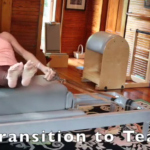Issue #317 – Wednesday, November 11, 2020
We’re Transitioning!
by Clare Dunphy Hemani
It took me awhile to appreciate how powerfully transitions impact the work of Pilates. Their purpose and importance in our development as practitioners and teachers cannot be overstated. Let’s break it down and look closer at the why’s, the how’s, and then we’ll watch some transitions in action.
Romana taught that transitions are a part of the exercise, and sometimes even feel harder than the exercise! They keep the flow of the workout moving by linking each exercise to the next with a minimum of extraneous movement including wardrobe fixing, fidgeting or anything that is unnecessary. The idea is to have control of your body in motion at all times to build your stamina, focus, and most importantly discipline.
Transitions increase the use of our brain and memory. The nervous system gets an uptick of activity as we reach for new movement habits. Our memory improves because we’re remembering not just the details of the movement, but what comes next and making choices about how to best get there. I think that’s the part I like best about Pilates – yes, we’re thinking but there’s a whole lot more going on than in our thinking mind, our bio-intelligence is developing as well. The body and mind are always learning during movement and moving well consciously leads us to moving well unconsciously.
Efficiently moving from one exercise to the next gives more time to build up to doing a greater number of exercises, which is one way to see progress. Efficiency also trains us to be less sloppy and get out the juice of an exercise on rep #1, which is not an easy task. This is what transfers into our daily life activities, and we become automatically better movers because we have trained our nervous system to work that way. We become aware of our habits so we can change them. Our movement character builds and a noticeable difference emerges in our carriage, grace, confidence, and poise.
Transition Tips on the Reformer
The overall principle for clean transitions is minimal movement to get to the next exercise. Here are some of my favorite tips:
Keep the springs in motion whenever possible. For example, when changing foot positions during Footwork Series, move both feet at the same time and make a swift change from the toes to arches to heels etc. so you keep the same rhythm and the springs alive. Try the same thing with Pull Straps, Long Stretch Series, Stomach Massage Series, and Knee Stretch Series.
No hesitation between reps or exercises. You do want to return the carriage fully without banging it and then go directly into the next rep. The same holds true between exercises unless you are taking an intentional rest. This means if your head is up, keep it up and just transition, instead of putting your head down and then lifting it up again which costs you 2 extra movements. If the exercise is over and you need to dismount the reformer, don’t rest, just get off the reformer. You’ll be amazed at how these little things save time, make you stronger, and improve your focus.
Challenge your transitions by mounting and dismounting on alternating sides so you don’t always lead with the dominant side. And a tip when changing springs is to put the handles in one hand and swing your legs around to the same side. Also, there’s no need to hang the straps just to have to pick them up again. Change your springs without letting your feet touch the floor and get strong enough so you can be in a Teaser position to change springs.
One way I like to up the ante for students as they progress, is by asking them to try using a maximum of two breaths to complete a transition, especially where they dismount and get the long box for example. Or, I give them 8 counts to get to where they are going, and I count down. It’s fun for them and they gain awareness of how to be more efficient.
Let’s take a look at the following transitions in action:
Pull Straps to Backstroke to Teaser to Breaststroke
Long Stretch Series
Stomach Massage Series
If you’d like to see more on transitions, check out these two videos:
Tips for Smooth Transitions (at Pilatesology).
Reformer Transition Tip (2 mins at Vimeo).
Clare Dunphy Hemani
Clare Dunphy Hemani My roots in the field of human movement began at Northeastern University in 1980 where I studied Exercise Science, continuing my education with certifications from PMA, ACE, and Romana Kryzanowska. I began my Pilates studies under Romana Kryzanowska in 1995 and continue my studies with master teachers to this day. I present on Pilatesology.com and PilatesAnytime.com, and host two free video channels on Vimeo.com for students and teachers. From 2001-2013 as co-author of the Peak Pilates Comprehensive Education Program, I mentored scores of teachers and teacher trainers, which opened my eyes to the value and need to coach the next generation of teachers. I’m committed to preserving the authenticity and tradition of The Pilates Method of Body Conditioning, and to creating learning environments that are refreshing, energetic and supportive. I’m the founder of Pilates Avatar®, a comprehensive audio program designed for practitioners of all levels to help them gain greater ownership of their practice. I also teach The Advanced Teacher’s Seminar, an annual Master’s Program. My gift is my willingness to share knowledge generously and explain concepts with clarity. My mission is simple: Get more people doing Pilates!
Follow Clare at www.progressivebodyworksinc.com and on Facebook and Instagram.


